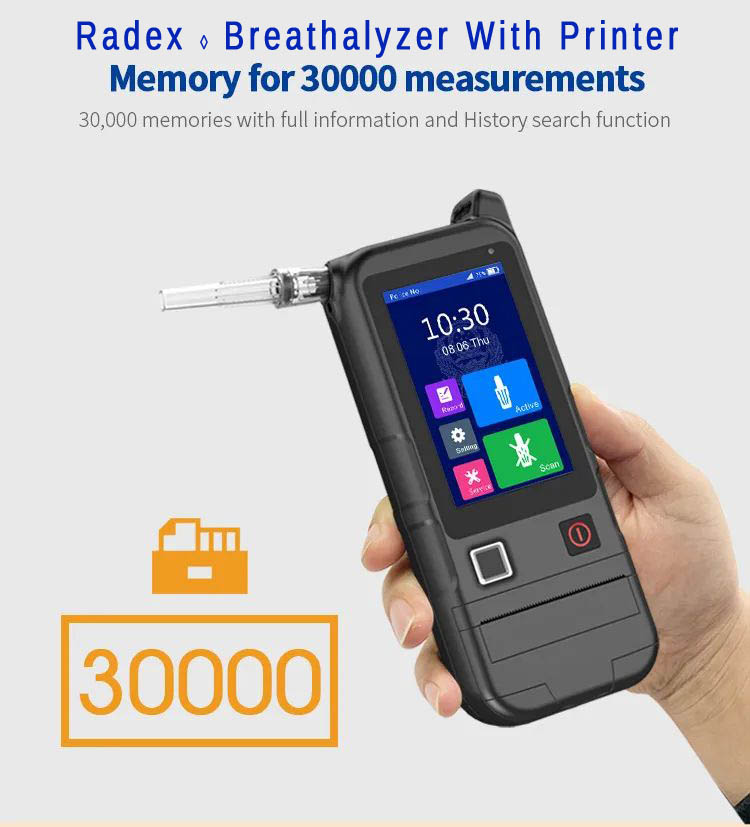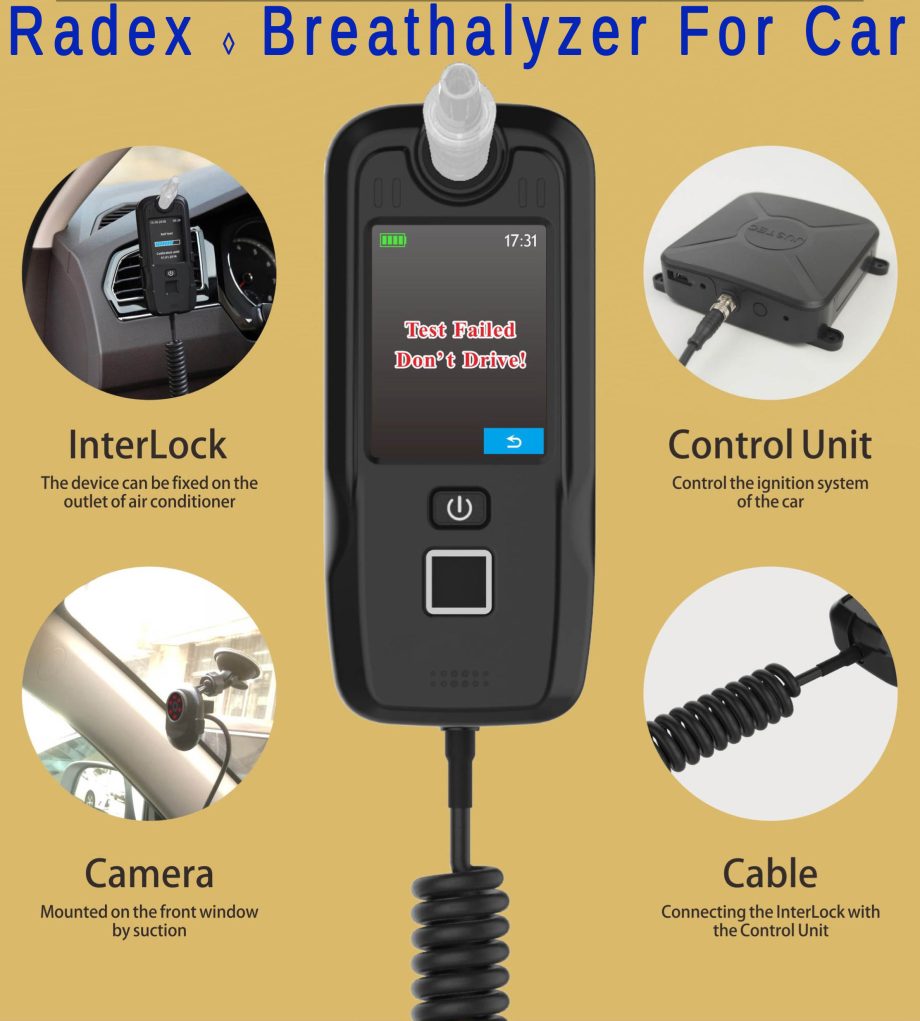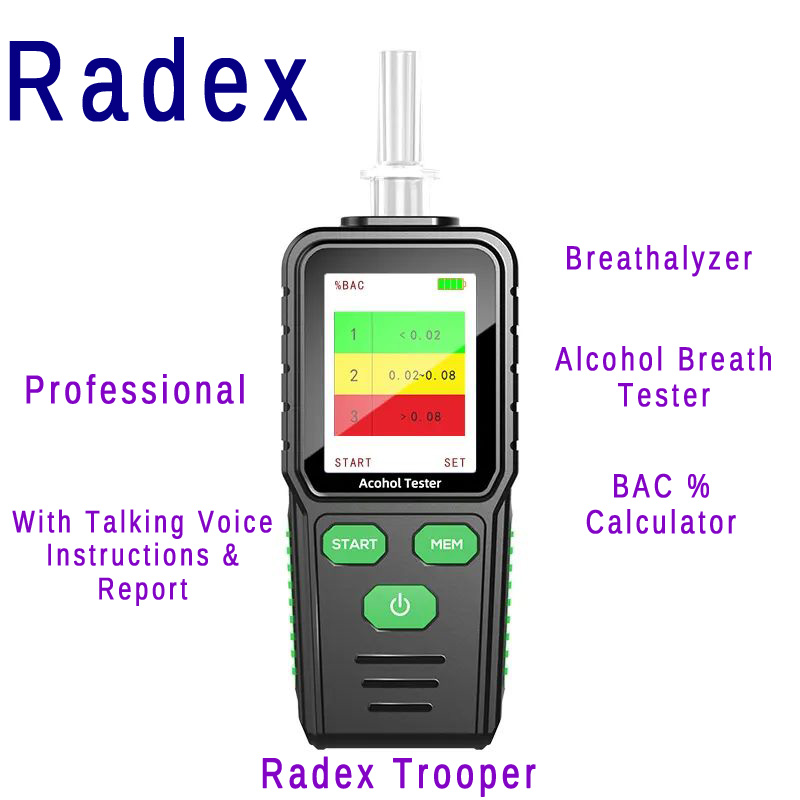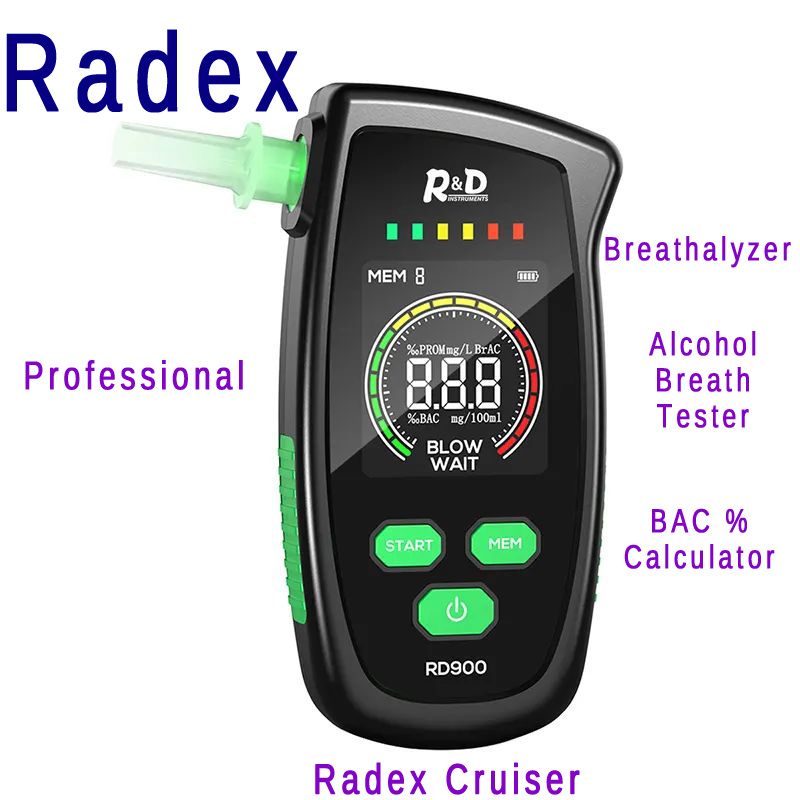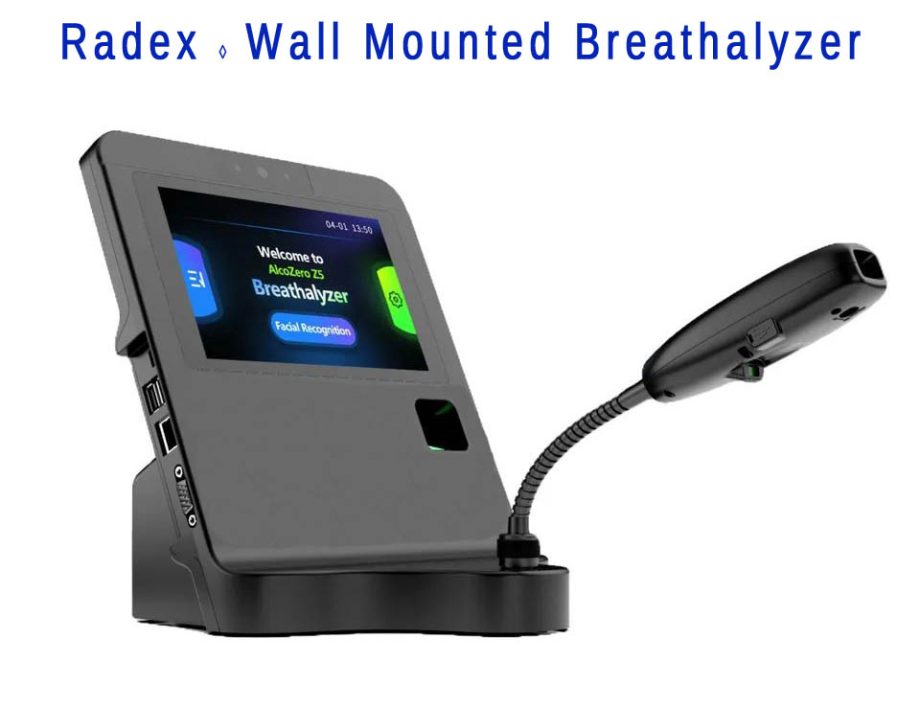-
Alcohol Breath Analyser With Printer
$499.95 -
Baiid Interlock Device
$899.95 -
Radex Alcohol Breath Tester
$89.95 -
Radex Breathalyzer
$69.95
What is a Breath Alcohol Tester?
Breath alcohol tests are used by law enforcement to measure the blood alcohol content (BAC) of suspected drunk drivers. Both personal breathalyzers and professional devices used by law enforcement use such tests to measure BAC. This device works by employing fuel cell or infrared sensors to detect alcohol molecules in your breath, and using these to generate an electrical current for reading out your BAC levels. These sensors then change color to provide an electrical reading of your level of intoxication.
What is a breath Alcohol Tester?
Breathalyzers (also referred to as breath alcohol testers or breathalyzers) are devices used to assess the amount of alcohol present in an individual’s blood by measuring exhaled breath. Police use breath alcohol testers during traffic stops as well as people being monitored for alcohol addiction such as rehab programs or court-ordered treatment for drunk driving or related offenses; individuals can purchase disposable breath alcohol tests.
Breath alcohol testing is relatively straightforward and takes less than one minute to complete. A person simply blows into a mouthpiece before breathing through a chamber filled with potassium dichromate and other chemicals in red-orange hue. As they breathe into this solution, any ethanol present reacts with it to turn it green, which is then measured using photocell technology that compares it against another chamber containing unreacted liquid in comparison. This produces electrical current, which then leads to an online display showing their blood alcohol content (BAC).
There is a measurable physiologic relationship between blood alcohol concentration and exhaled breath ethanol levels. Law enforcement agencies utilize several different kinds of breath alcohol analyzers ranging from handheld handheld units for roadside testing and stationary evidentiary breath testing instruments located at police stations.
Fuel cell gas sensors or IR spectroscopy technology is generally considered the best evidence-gathering technology, providing great sensitivity and specificity when measuring ethanol concentration levels in breath samples taken for evidentiary purposes. Such tests are commonly employed against drunk drivers in criminal proceedings for reliable results.
People undergoing alcohol monitoring programs or probation for DUIs typically need to submit to ongoing breathalyzer testing. Breathalyzer tests may also be mandatory as part of child custody arrangements or legal issues; refusing a breath test in these instances could result in civil fines for violating their state’s implied consent laws.
How is a breath Alcohol Tester done?
Breath alcohol tests measure the amount of alcohol you exhale. You can conduct them either manually or electronically. A common manual device involves using a balloon attached to a tube filled with yellow crystals; when you blow into this device, their colors change according to how much alcohol is in your breath. However, read all instructions thoroughly prior to conducting these tests as factors such as mouth infections, medications and mouth-alcohol could all skew results negatively.
When drinking alcohol, the substance passes from your stomach and small intestine, into your bloodstream, then to your lungs and brain before being exhaled through breathing out. A breath alcohol test measures the alcohol vapor present in your lungs to provide an estimate of your BAC (blood-alcohol content).
Disposable devices can be found in pharmacies or online. People concerned with drinking and driving or employers conducting drug testing use them. Some states mandate breath alcohol tests as part of driver licensing processes; many companies include such tests in employee handbooks; court orders frequently require these exams as part of custody agreements or DUI convictions.
Police officers employ more advanced electronic devices for breath alcohol testing. These larger than portable devices often resemble walkie-talkies in size and provide instantaneous readings of your BAC when you blow into them, with built-in safeguards against false positives from mouth alcohol or malfunction. When taking multiple samples for testing purposes they may ask that one blows into it several times while using reference samples to get an average reading. Furthermore, interference detection measures the time between responses from chemical meters in meter and color changes so if interference is registered it can be stopped and another blood or urine test will likely need to take place.
What are the results of a breath alcohol tester?
Breath alcohol tests are designed to determine how much alcohol is in your system. When you breathe into the device, it measures the alcohol in your exhaled air which reflects your blood alcohol content (BAC). Testing may be conducted for either DOT or non-DOT purposes and usually require two blows; one reading will serve as verification, while the second one will determine your BAC and be reported immediately after completion of testing.
A typical breath alcohol tester is an electronic instrument that utilizes infrared technology for analysis of a sample. An infrared sensor detects alcohol-laden breath vapor and changes its color on a crystal display screen, before calculating your BAC by dividing total vapor by your weight in kilograms and factoring temperature changes to account for changes to blood alcohol concentration due to environmental conditions.
Manual breath alcohol tests can also be conducted manually with an older model known as the drunkometer. This device used a balloon to collect breath samples before pumping them through an acidified potassium permanganate solution which then altered its color when reacting with the chemical and breaking down ethanol content in your breath sample. It was once considered the first practical roadside breath test commercially available.
When taking a breath alcohol test, there are certain variables that can alter its results. According to research at the University of Washington, the volume of mouth air being forced through matters. If your breathing doesn’t force all the alcohol through, your results could be higher than actual.
Factors that may skew a breath alcohol test results include food in your mouth, gum disease or untreated cavities; chewing tobacco (particularly stick tobacco), can trap mouth alcohol that doesn’t escape when making the strong blowing effort required to fill a machine; those suffering from ulcers may also experience reflux that gives a false positive result.
How can a breath alcohol tester help a driver?
Breath Alcohol Testers are used to measure the amount of alcohol present in drivers’ systems. Available both for home use and law enforcement officers’ handheld devices on the road, and portable breath testers are more accurate in measuring alcohol than some types of disposable handheld versions and more portable – making them easier for officers to carry and operate when on duty. Unfortunately, breath testing devices can sometimes produce inaccurate results due to factors like diabetes affecting its interpretation: this may result in false positives whereby acetone in their body is misread as alcohol; such results could have far-reaching implications on DUI/DWI prosecutions proceedings.
Furthermore, devices can be affected by mouth or tongue interference that makes results fluctuate and are difficult to interpret. Furthermore, breath alcohol testers require users to blow steadily for the correct duration; failure to follow these instructions could produce inaccurate readings as could improper calibration and maintenance of the device producing false readings – this is why having an experienced DUI lawyer review your breath test or blood alcohol level results is vitally important.
COPD patients or others suffering from lung conditions may not be able to blow hard enough into a device for an accurate reading, while those suffering from recent dental work or gastroesophageal reflux disease (GERD) could also have difficulty providing an accurate reading. Drivers should be aware of these potential errors so they can present a strong defense in court should any questions arise about them.
Breath testing remains an integral tool of police officers on the road, even with its inherent errors. Under law, those suspected of DUI must provide either breath or blood samples after arrest for testing – known as an “implied consent” law and any violation can lead to an automatic one year license suspension.
After being charged with drunk driving, individuals may be required to install an ignition interlock device on their car after court proceedings have concluded. This device requires the driver to submit to a breath test prior to starting up their car – this prevents over the legal limit drivers from starting up their vehicles while also mandating periodic retests.
How a Breath Alcohol Test Can Prevent Accidents
Breath alcohol tests measure how much alcohol is present in your system through the air you exhale. They may be either electronic or manual tests; for manual ones, manually administered tests typically involve balloon and glass tube with yellow crystals that change colors upon being inhaled.
This test can assist law enforcement, hospitals and workplaces in preventing accidents by detecting an elevated blood alcohol content. It has become widely utilized by these entities.
BAC Accuracy
A breath alcohol tester is used to measure how much alcohol is present in your system, or blood alcohol concentration (BAC). Your BAC levels increase with each drink you take, potentially leading to slow reactions, poor judgment and other undesirable consequences. A personal alcohol breath analyzer can help prevent DUIs while increasing safety.
Breath tests may be conducted either manually or electronically, with manual methods using a balloon and tube that collects samples; they then pass them through an acidified potassium permanganate solution to determine how much alcohol there is present. Electronic breathalyzers, which are much easier to use and provide more accurate readings by comparing their results against a standard calibration, also exist.
Certain breathalyzer models are more accurate than others; the ideal ones should be easy to use and provide results within 10-15 seconds after blowing into them; additionally, their battery should last long-term.
Alcohol Tester Safety
Utilizing an alcohol breath tester is a safe and efficient way to ensure drivers aren’t impaired before getting behind the wheel. Also known as breathalyzers, these devices provide accurate readings of your blood alcohol content (BAC). Because BAC levels can rise quickly after drinking alcohol, it’s vital that drivers regularly test their BAC before heading out onto the roads.
A DOT-compliant alcohol tester is simple and straightforward, featuring a single-use mouthpiece to protect against contamination during administration. The device utilizes chemical reactions to detect alcohol, with results displayed via color changing needle.
Employees performing safety-sensitive functions in aviation, motor carrier and railroad industries must submit to alcohol testing by the Department of Transportation (DOT). This includes flight crew members, aircraft attendants/instructors/controllers, maintenance personnel and armed security staff – ensuring no abuse of alcohol occurs while performing their duties. This regulation seeks to ensure employees do not misuse alcohol during performance of duties.
Alcohol Tester Reliability
Use of a breath alcohol tester can be invaluable to your safety, helping prevent accidents or having your license suspended. These accurate devices can be taken anywhere; however, products which could alter test results such as mouthwash or breath fresheners should be avoided prior to testing; additionally, your device may need calibration or battery replacements.
Chemical oxidation and photometry is used to test someone’s blood alcohol content. The device consists of a mouthpiece connected to two chambers filled with potassium dichromate and other chemicals; when you blow into the mouthpiece, alcohol in your breath interacts with these chemicals to cause color changes that are monitored by meters; any differences are converted into electrical current and eventually converted to an BAC reading by police officers using electronic devices similar to walkie-talkies.
Cost to business owners
As the owner of an establishment that serves alcohol, it would be prudent to include a breathalyzer. These devices can provide great value to both drivers and passengers by helping to prevent drunk driving accidents. A good breathalyzer should work quickly and accurately while withstanding frequent usage.
There are various kinds of breathalyzers, from semiconductor to fuel cell sensors. The latter works by producing electricity whenever there is any ethanol present in a person’s breath; this type of device tends to be more expensive but more accurate.
These alcohol tester devices can be used to pre-screen workers before hiring, test employees after an accident or incident to assess whether alcohol contributed, conduct random tests across an organisation and produce accurate, admissible results that can be presented in court proceedings – making them perfect for use with armed forces, schools, police check points and prison populations.
